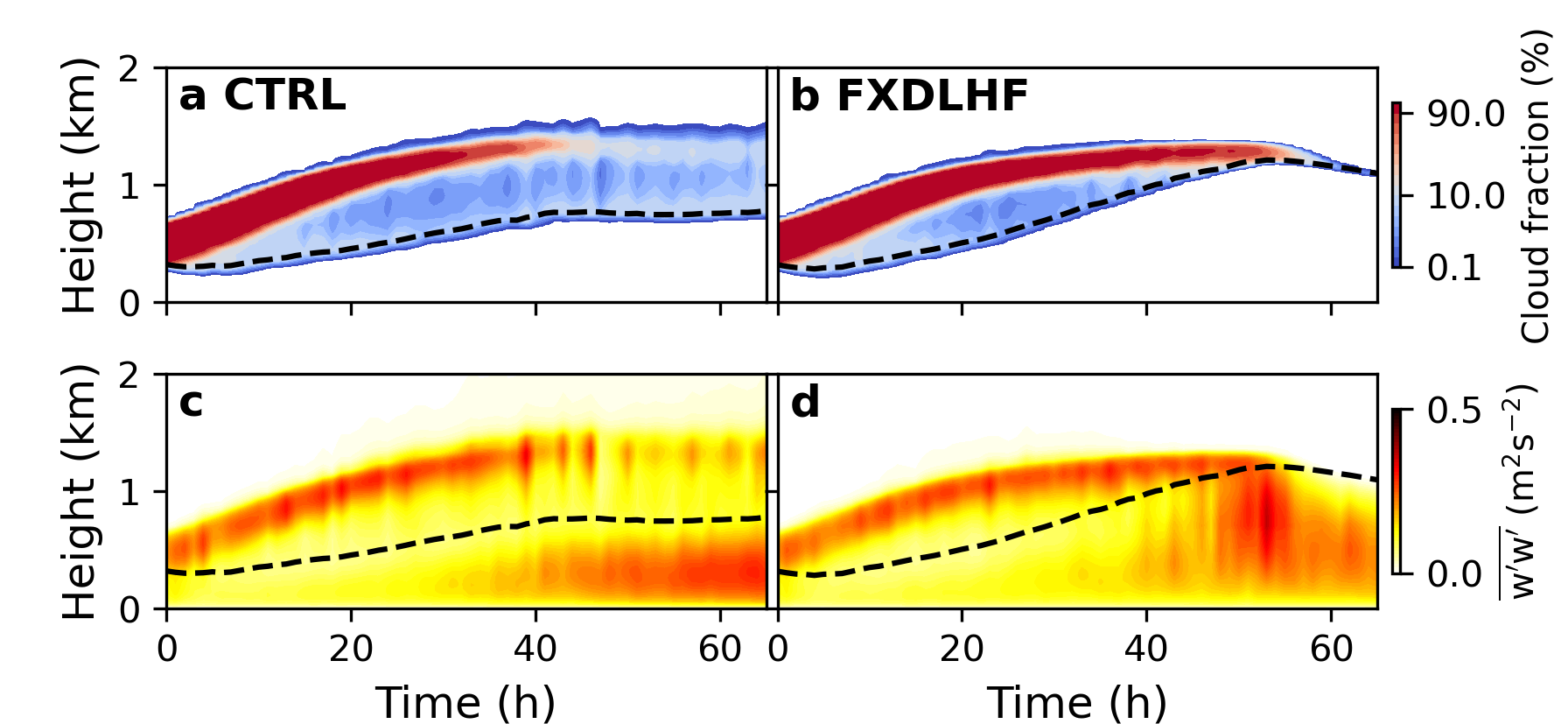Revisiting the deepening-warming decoupling theory
Submitter
Zheng, Youtong — University of Houston
Area of Research
Cloud Processes
Journal Reference
Zheng Y, H Zhang, and Z Li. 2021. "Role of surface latent heat flux in shallow cloud transitions: A mechanism-denial LES study." Journal of the Atmospheric Sciences, 78(9), 10.1175/JAS-D-20-0381.1.
Science

Figure 1. Evolutions of the stratocumulus-topped boundary layers in the control run (left) and mechanism-denial run in which the surface latent heat flux is fixed (right). The upper and lower panels correspond to the cloud fraction and vertical velocity variance, respectively. The dashed lines are the lifting condensation level. From journal.
An important but poorly understood phenomenon about the stratocumulus (low-lying blanket-like clouds) is its tendency to transition to cumulus clouds (cauliflower-like clouds) as the sea surface warms, called the stratocumulus-to-cumulus transition (SCT). The conventional wisdom is that the SCT is primarily driven by the enhanced evaporation of seawater. We revisit and advance this conventional wisdom using a theory and a large-eddy model.
Impact
We find that boundary-layer decoupling can happen without the need for the surface latent heat flux to increase as long as the capping inversion is weak enough to ensure high entrainment efficiency.
Summary
Surface latent heat flux (LHF) has been considered as the determinant driver of the SCT. The distinct signature of the LHF in driving the SCT, however, has not been found in observations. This motivates us to ask, how determinant is the LHF to SCT? To answer this question, we conduct large-eddy simulations in a Lagrangian setup in which the sea surface temperature increases over time to mimic a low-level cold-air advection. To isolate the role of LHF, we conduct a mechanism-denial experiment in which the LHF adjustment is turned off. The simulations confirm the indispensable roles of LHF in sustaining (although not initiating) the boundary-layer decoupling (first stage of SCT) and driving the cloud regime transition (second stage of SCT). However, using theoretical arguments and LES results, we show that decoupling can happen without the need for LHF to increase as long as the capping inversion is weak enough to ensure high entrainment efficiency. The high entrainment efficiency alone cannot sustain the decoupled state without the help of LHF adjustment, leading to the recoupling of the boundary layer that eventually becomes cloud-free. Interestingly, the stratocumulus sheet is sustained longer without LHF adjustment. The mechanisms underlying the findings are explained from the perspectives of cloud-layer budgets of energy (first stage) and liquid water path (second stage).
Keep up with the Atmospheric Observer
Updates on ARM news, events, and opportunities delivered to your inbox
ARM User Profile
ARM welcomes users from all institutions and nations. A free ARM user account is needed to access ARM data.


















